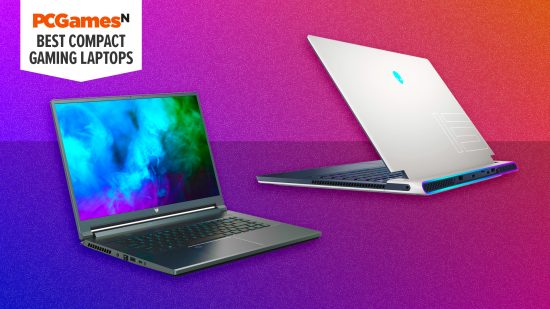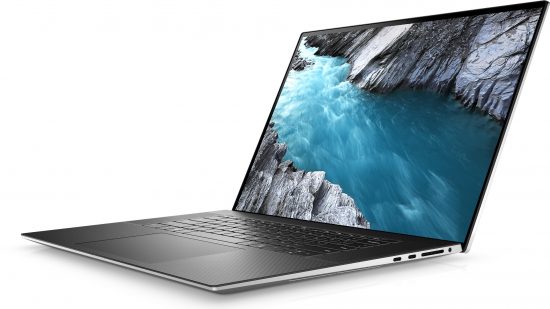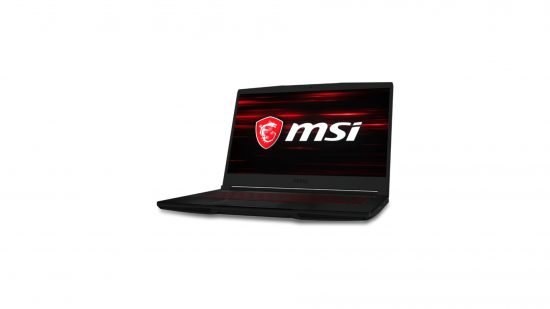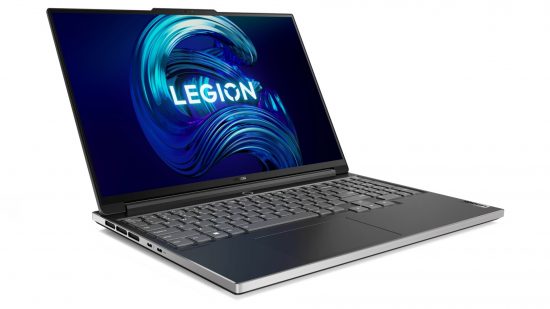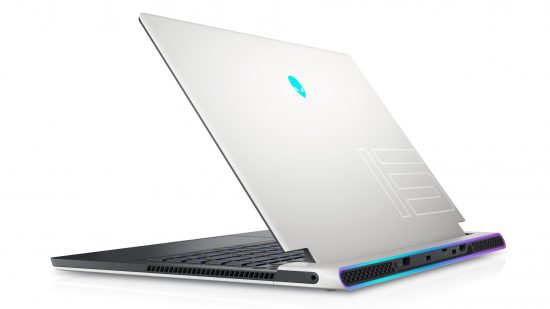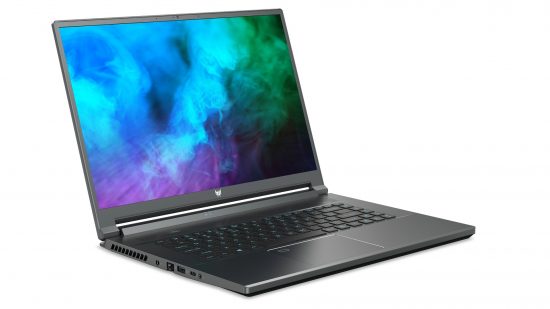The best thin and light laptops offer the best in portability, whether you’re away from your desk or on the move. Portability doesn’t mean you have to sacrifice power, either. Today’s small laptops for gaming combine lightweight materials, sophisticated cooling tech, and smaller components to deliver comparable gaming performance to bigger laptops and the best gaming PCs.
We rate the latest Asus Zephyrus G14 series of Asus gaming laptops. It offers a gorgeously light chassis surrounding blisteringly powerful hardware that’ll set you up for years to come. Expect to pay a premium for the latest in benchmark-busting performance, though. If you’re more budget-focused, the MSI GF63 Thin cleverly blends a high-end RTX GPU with slightly lower-spec hardware, but at under $1,000/£1,000, it’s an absolute steal.
Compact laptops are usually thinner than 1 inch and under 2 kg in weight. Design is important if you want a sleek laptop that could look the part in the office or library and still have pride of place as a mainline gaming rig. You’ll also need to consider the capabilities of its GPU and CPU and display quality — size, resolution, refresh rate, and pixel density. All the compact gaming laptops in this guide have at least 16 GB of RAM and 512 GB of disk drive space.
Why you can trust our advice ✔ At PCGamesN, our experts spend hours testing hardware and reviewing games and VPNs. We share honest, unbiased opinions to help you buy the best. Find out how we test.
Best thin and light laptops in 2024:
Asus Zephyrus G14
Best thin and light gaming laptop overal
Asus Zephyrus G14 specifications:
| Graphics |
Up to NVIDIA GeForce RTX 4090 |
| CPU |
Up to AMD Ryzen 9 7940HS |
| RAM |
Up to 32 GB |
| Storage |
512 GB / 1 TB SSD |
| Connectivity |
Wi-Fi 6E, Bluetooth 5.3 |
| Screen |
14-inch up to QHD+ (2560 x 1600), 165 Hz |
| Size |
312 x 227 x 19 mm (12.3 x 8.9 x 0.7 in) |
| Weight |
1.65–1.72 kg |
Reasons to buy
- Lovely design
- Battery life could be better
- Powerhouse performance
Reasons to avoid
- Can be very expensive
- Battery life could be better
The Asus Zephyrus G14 boasts impressive performance and a satisfactory display, all encased within an incredibly thin and lightweight notebook. Returning to the NVIDIA RTX chipset after experimenting with Radeon in 2022, this latest laptop lineup from Asus also incorporates a webcam, albeit a slightly outdated 1080p lens. Unfortunately, battery life has suffered in comparison to previous models due to increased power consumption.
While the G14 showcases significant graphical prowess, opting for a top-tier configuration with the NVIDIA GeForce RTX 4090, AMD Ryzen 9 7940HS, and a mini LED QHD 165Hz display comes at a hefty price. For those seeking affordability, selecting a mid-to-high range version of this Asus gaming laptop might be a more practical choice. Design-wise, the Zephyrus impresses with its modern lines and understated aesthetic, suitable for both professional and leisure settings.
The AniMe Matrix display offers a unique feature by displaying dotted images and GIFs on the laptop lid. While it may seem gimmicky to some, it underscores Asus’ commitment to innovative design. Despite its premium price tag, the G14 stands out as one of the smallest and lightest high-end gaming laptops available, weighing just 1.72 kg and measuring a slim 20.5 mm thick. The G14 offers power and performance in a compact and visually appealing chassis, and it’s a formidable option in a competitive market if your budget can stretch.
Dell XPS 17
Best 17-inch thin and light laptop
Dell XPS 17 specifications:
| Graphics |
NVIDIA GeForce RTX 4080 |
| CPU |
Up to 13th Gen Intel Core i9-13900H |
| RAM |
Up to 64 GB DDR5 |
| Storage |
Up to 5 TB SSD |
| Connectivity |
Wi-Fi 6, Bluetooth |
| Screen |
17-inch, up to UHD (3840 x 2400) InfinityEdge touchscreen |
| Size |
374 x 248 x 19 mm (14.7 x 9.8 x 0.8 in) |
| Weight |
2.31–2.44 kg |
Reasons to buy
- Touch display
- Bright screen
- Superior processing power
Reasons to avoid
- Only 720p webcam
- Not a dedicated gaming machine
The XPS 17 is great if you’re a creative by day as well as a gamer. Dell has boosted the processing power while maintaining its core features, which isn’t necessarily a drawback. The laptop boasts an aluminum shell complemented by a carbon-fiber keyboard, embodying the XPS series’ commitment to premium construction. However, its weight of up to 2.44 kg sets it apart as one of the heaviest models in its category.
At the helm of the top-tier XPS 17 lies Intel’s 13th-gen i9-13900H processor, delivering pleasing speed for tasks like Photoshop and Premiere Pro. Graphics are handled by the NVIDIA RTX 4080, adding another layer of performance. Nevertheless, the inclusion of an option for a 17-inch touch panel and the powerful processor contribute to its relatively high price point, even for the base model.
The XPS 17’s standout feature is its stunning InfinityEdge display. With a UHD+ resolution and nearly borderless design, coupled with a brightness rating of 500 nits, the screen enhances both work and entertainment experiences. Despite its impressive specifications, the XPS 17 falters with its underwhelming 720p camera, detracting from an otherwise stellar package.
While dedicated gamers might seek alternatives, professionals such as video editors, analysts, and designers may find the XPS 17 to be a solid choice, thanks to its sleek design and robust performance capabilities.
MSI GF63 Thin (2023)
Best budget thin and light laptop
MSI GF63 Thin (2023) specifications:
| Graphics |
Up to NVIDIA GeForce RTX 4050 |
| CPU |
Up to 12th Gen Intel Core i7 12650H |
| RAM |
Up to 64 GB DDR4 |
| Storage |
512 GB SSD |
| Connectivity |
Wi-Fi 6, Bluetooth 5.2 |
| Screen |
15.6-inch Full HD (1080p), up to 144Hz |
| Size |
359 x 254 x 22 mm (14.1 x 10 x 0.85 in) |
| Weight |
1.86 kg |
Reasons to buy
- Great value
- Good build quality
- High-quality speakers
Reasons to avoid
- Low-res 720p webcam
- Rivals have better keyboards
- Screen could be brighter
A thin and light MSI laptop with NVIDIA RTX 40 series for under a grand? That seems like a bargain, especially with MSI’s penchant for solid build quality and reliability. Of course, don’t expect benchmark-dominating performance — this is as budget as gaming laptops with a dedicated GPU get. However, surprisingly, you’ll get a decent gaming experience out of it thanks to the RTX GPU and last-gen i7 Core Raptor Lake CPU, which still holds up compared with today’s Alder Lake chipset.
That means you’ll probably be fine running most contemporary games with mid-range settings on the supplied 1080p panel. Its 144 Hz refresh rate makes it perfect for playing twitchy esports where you need a smooth and responsive experience.
We’re also impressed with the GF63’s no-frills chassis. There’s some bend in its frame because it’s a thin machine, but the black casing, brushed aluminum finish and red backlit keyboard make for a fairly sleek aesthetic. Speaking of the keyboard, there’s some flex in the frame, so we’re not sure about using the laptop as an everyday device, especially as the webcam is only 720p.
MSI got the memo that having a decent GPU is one of the most important aspects of a gaming laptop. Its other specs are generally a combination of last-gen tech that still holds up fairly well. All this makes the GF63 a seriously affordable contender in the gaming laptop market and practically impossible to resist for those on a budget.
Legion Slim 7i Gen 7
Best mid-range thin and light laptop
Legion Slim 7i Gen 7 specifications:
| Graphics |
Up to NVIDIA GeForce RTX 3070 |
| CPU |
Up to 12th-gen Intel Core i7-12700H |
| RAM |
Up to 32 GB DDR5 |
| Storage |
1 TB SSD |
| Connectivity |
WiFi 6E, Bluetooth 5.1 |
| Screen |
16-inch WXQGA 2.5K 165-240 Hz |
| Size |
358 x 256 x 17 mm (14.1 x 10 x 0.67 in) |
| Weight |
2.05kg |
Reasons to buy
- Great selection of ports
- Strong speakers
- Excellent screen
Reasons to avoid
- Design uninspired
- Shallow keyboard
The Legion Slim 7i Gen 7 is one of the best Lenovo gaming laptops. It’s impressive that Lenovo has crammed so much into its tiny 17 mm thick frame. It’s a laptop that can do everything and suit any setting. And even though the keyboard features little travel, there is a numeric keypad.
The combination GeForce RTX 3000 series paired with the Intel Core i7 means it can handle number crunching, video stream editing, or polygon wizardry. However, as the Intel i9s and RTX 4000 series are now among the gold standard, it throws cold water on the Slim 7i’s futureproofing capabilities.
We love this model’s display panel. There’s a choice between a 1080p or 2.5K screen, with the former getting a 240 Hz refresh rate and the latter 165 Hz. We’re also big fans of its near borderless screen, which is rich in color and runs at a max 500 nits — plenty bright enough. The anodized, thin, and light aluminum chassis looks mature, although its restrained look might deter hardcore gamers.
Alienware x15 R2
Best designed thin and light laptop
Alienware x15 R2 specifications:
| Graphics |
Up to NVIDIA GeForce RTX 3080 Ti 16GB |
| CPU |
Up to Intel Core i9 12900H |
| RAM |
Up to 32 GB |
| Storage |
Up to 4 TB SSD |
| Connectivity |
Wi-Fi 6E, Bluetooth 5 |
| Screen |
15.6-inch up to 1440p 165-350 Hz |
| Size |
360 x 277 x 12.5 mm (14.2 x 10.9 x 0.5 in) |
| Weight |
2.27 kg |
Reasons to buy
- High performance
- Super slim
- Beautifully designed
Reasons to avoid
- No ethernet port
- Runs hot a lot of the time
- Bad battery life
Alienware gaming laptops have always stood out from the crowd for their striking designs, and the x15 R2 is no exception. Featuring an unfathomably thin profile, it makes you wonder what witchcraft goes on at Dell to craft this gorgeous gaming rig with a sub-16mm girth. To be fair, it does sit wider, so be sure to measure your backpack to ensure a decent fit.
Heads will be turned by the x15’s outer stylings, particularly where the hinge has been moved away from the back edge. A futuristic “15” also adorns the lid, which comes with a lit Alienware logo. Most notably, surrounding the rear ports is a customizable RGB ring of light that’s straight out of Tron.
Its innards prove it’s no slouch either. With premium specs, including an Intel i9 processor and RTX 3000 series GPU, performance will always be on point. And we love how gorgeous the display is, which can go up to 1440p with a minimum refresh rate of 165 Hz. Battery life is disappointing, and despite having a generous set of ports, an ethernet connection is a puzzling omittance.
Acer Predator Triton 500 SE
Best thin and light laptop with 1440p display
Acer Predator Triton 500 SE specifications:
| Graphics |
Up to NVIDIA GeForce RTX 3080 Ti |
| CPU |
Up to Intel Core i9 12900H |
| RAM |
Up to 32 GB LPDDR5 |
| Storage |
Up to 2 TB SSD |
| Connectivity |
Wi-Fi 6E, Bluetooth 5.1 |
| Screen |
16-inch 2.5 K, 165–240 Hz |
| Size |
358 x 261 x 19 mm (14.1 x 10.3 x 0.78 in) |
| Weight |
2.27kg |
Reasons to buy
- Responsive display
- High performance
- Great 1440p panel
Reasons to avoid
- Fair bit of fan noise
- Runs hot
- Outclassed by some rivals
The Acer Triton 500 SE, coated in all-metal grey, exudes a classy and understated aesthetic. While it may appear more like a high-end business machine at first glance, it seamlessly blends into office environments without drawing too much attention. Its standout feature is the refined 16-inch screen boasting a 16:10 aspect ratio, ideal for navigating text-heavy documents with ease, thanks to its 2.5K resolution, high refresh rate, and 500-nit brightness.
Despite the dominance of the NVIDIA 4000 series in graphics, the Triton 500 remains a gaming powerhouse with its high-end 3000 Ti chipset. It delivers buttery smooth performance even with triple-A titles at maxed settings and 1440p resolution, all within a laptop under 2 cm thick. However, some may find better value in equally capable alternatives. Moreover, the Triton 500’s impressive brightness and performance come with the trade-off of increased heat and fan noise, addressed by Acer’s inclusion of a “Turbo” fan mode accessible via a dedicated keyboard button.
As well as performance, the Triton 500 offers ample connectivity options, including USB-A, Thunderbolt, HDMI, and an SD card reader – catering to various needs, particularly for professionals dealing with image files. With its sturdy chassis, strong screen and graphics, and commendable productivity features, the Triton 500 stands as a reliable workhorse suitable for any time of day.
Are gaming laptops getting lighter?
Absolutely. Efficiencies in crafting smaller integrated circuits have resulted in much tinier hardware components. Combine that with better heatsink systems and lightweight materials, and you have gaming laptops that approach ultrabook levels of size and portability.
These laptops feature more power and larger screen real estate, and they can comfortably balance on a single hand. They’re also ideal for taking to work and back home, thanks to their diminutive frame and lightweight nature.
How to choose the best thin and light gaming laptops
It’s all about the specs box. The most important specification to consider is power, which is determined partly by your central processing unit (CPU) but primarily by your graphics processing unit (GPU). You generally can’t upgrade these after purchase, and they’ll be key determiners in what games you can run.
A decent GPU will also help futureproof your machine for a good few years, so get the best your budget can allow. And while integrated chipsets are often cheaper, they’re generally not up to handling the most graphics-intensive games, so always plump for a dedicated graphics card.
Next to consider is RAM, for which we’d always recommend getting at least 16 GB. Some models are upgradeable, but right now, a decent CPU and GPU with 16 GB should serve you fine.
Storage is another big consideration depending on what you’re playing. Those triple-A titles will eat heavily into your gigabytes, so 512 GB or even 1 TB is recommended if you’re running lots of large games. While you can choose between traditional hard disk drives and solid state drives — the latter of which are much faster but a lot more expensive — some laptops include both in their architecture.
Next to consider is your display, and here you’ll need to balance speed and pixels. Speed is determined by your refresh rate, the most basic of which is 60 Hz, and while this is typically fine for most gamers, competitive or FPS players might find more benefit with 120 Hz or 144 Hz. There are options beyond this, but most won’t notice the difference. Pixel density is defined as the ratio of your screen size and its resolution, giving you pixels per inch (PPI). A PPI of around 100+ is decent, though 140 or above is ideal for competition play.
Finally, consider battery life. The most powerful gaming laptops are a huge power drain, so don’t expect to get more than 1–2 hours of untethered play, unless you’re playing indie titles. Realistically, you’ll always need to be near a mains connection.
We chose these laptops through a combination of personal experience and researching leading models from key industry players in the field. Find out more about how we test, review, and rate on PCGamesN.
